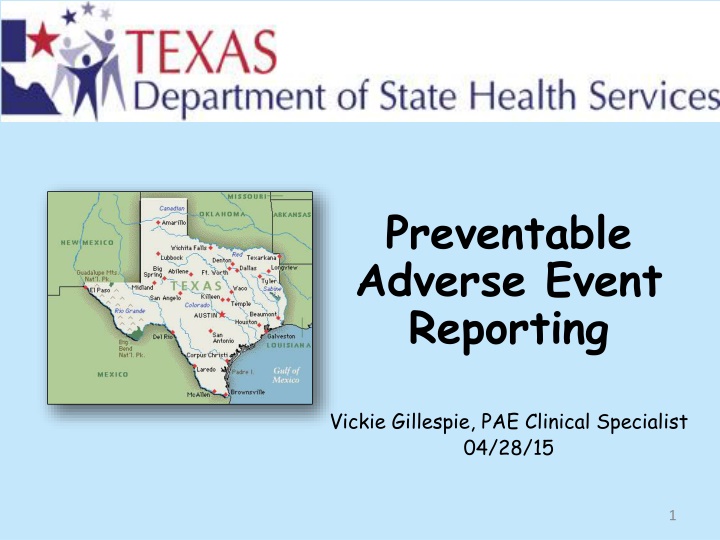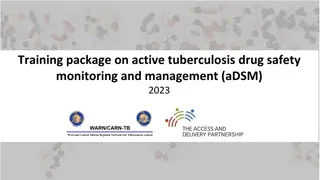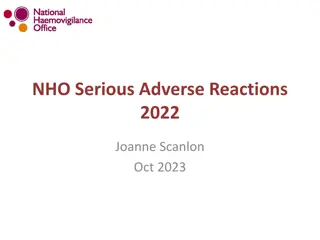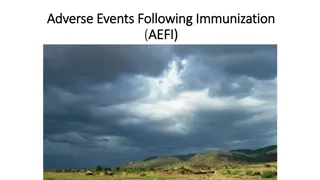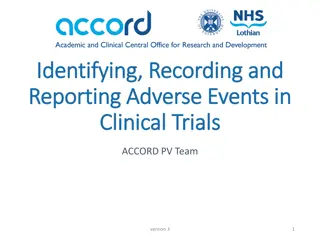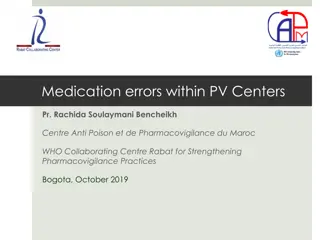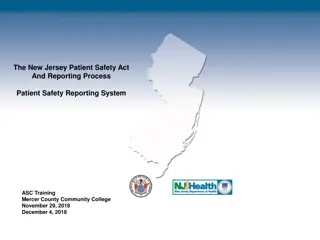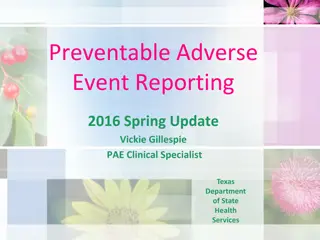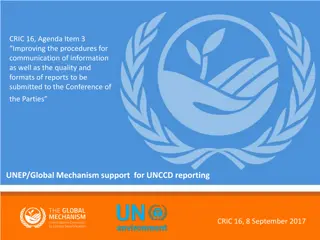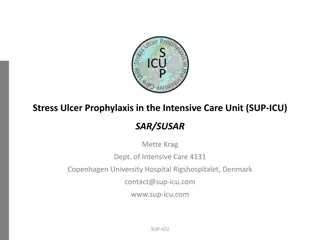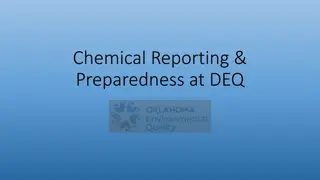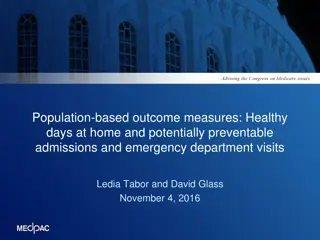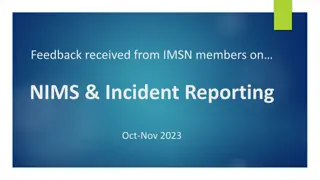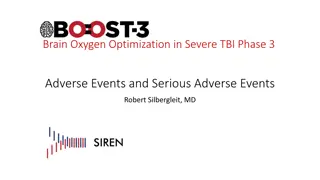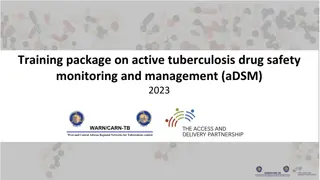Preventable Adverse Event Reporting Overview
This content discusses the importance of reporting preventable adverse events in healthcare, highlighting the scope of the problem, reasons for reporting, and the Swiss Cheese Model of errors. It emphasizes the need for effective reporting as a cornerstone of safe practice and a measure of progress towards a safety culture.
Download Presentation

Please find below an Image/Link to download the presentation.
The content on the website is provided AS IS for your information and personal use only. It may not be sold, licensed, or shared on other websites without obtaining consent from the author.If you encounter any issues during the download, it is possible that the publisher has removed the file from their server.
You are allowed to download the files provided on this website for personal or commercial use, subject to the condition that they are used lawfully. All files are the property of their respective owners.
The content on the website is provided AS IS for your information and personal use only. It may not be sold, licensed, or shared on other websites without obtaining consent from the author.
E N D
Presentation Transcript
Preventable Adverse Event Reporting Vickie Gillespie, PAE Clinical Specialist 04/28/15 1
Preventable Adverse Event (PAE) Reporting in Texas Objectives: Review the background of Preventable Adverse Event reporting nationwide and in Texas. Summarize the reporting program. Share Texas reported events to date. Adverse Event: An event that results in unintended harm to the patient by an act of commission or omission rather than by the underlying disease or condition of the patient. 2
Why Report? 1999 Institute of Medicine (IOM)* Estimated 98,000 deaths/year Most were systemic errors Called for a nationwide, mandatory reporting system 2013 John T. James, PhD** 2008-2011 four studies estimated a lower limit of 210,000 deaths/year Newest estimate is 440,000 deaths/year Serious harm 10-20 times higher than lethal harm (2-4 Million serious harm events/year) *To err is human: building a safer health system. Kohn LT, Corrigan JM, Donaldson MS (Institute of Medicine). Washington, DC:National Academy Press, 2000. **A New, Evidence-based Estimate of Patient Harms Associated with Hospital Care, James, John T. PhD, Journal of Patient Safety: September 2013 - Volume 9 - Issue 3 - p 122-128 3
Scope of the Problem Falls 700,000-1,000,000 falls annually1 Leading cause injury-related death 65 & older $30 billion by 20202,3 Pressure Ulcers 257,412 Medicare patients 20071 60,000 patients die annually from HA PUs Average charge of $43,1804 Medication Errors 1000/day in hospitalized pts5 15/100 admissions 75% preventable6 HAIs 2 Million annually in US7 (200,000 in Texas8) ~ 90,000 deaths (8-9000 Texas deaths) ~ $5 billion - $ 31.5 billion2 healthcare costs 4
World Health Organization Healthcare prone to accidents Greatest contributor is human error Most human errors induced by system failures Reason s Swiss Cheese Model One solution is reporting By doctor, nurse or other provider within an organization By the organization to a broader audience Effective reporting Cornerstone of safe practice Measure of progress toward a safety culture Draft Guidelines for Adverse Event Reporting and Learning Systems, World Alliance for Patient Safety, World Health Organization, 2005 5
Reasons Swiss Cheese Model Organization s layers of protection/defenses against hazards Holes represent weaknesses/gaps Hazards Med Adm Organizational influences Low focus on safety Unsafe supervision Less time for orientation Precondition for unsafe act Look alike drugs on same shelf Losses Med Error Unsafe act Administering incorrect drug Source: Reason J. Human error: models and management. BMJ. 2000 Mar 18;320(7237): 768-70. 6
World Health Organization Healthcare prone to accidents Greatest contributor is human error Most human errors induced by system failures One solution is reporting By doctor, nurse or other provider within an organization By the organization to a broader audience Effective reporting Cornerstone of safe practice Measure of progress toward a safety culture Draft Guidelines for Adverse Event Reporting and Learning Systems, World Alliance for Patient Safety, World Health Organization, 2005 7
Reasons for PAE Reporting Establish Standards Systemic Learning Transparency Evidence-based Practices Consumer s right to know Increase Patient Safety 8
AHRQ 2014 Healthcare Quality and Disparities Report Between 2010 and 2013: Patient Safety improved 17% reduction in rates of hospital-acquired conditions. Half of Patient Safety measures improved 1.3 million fewer harms to patients 50,000 lives saved (est) $12 billion in cost savings (est) 9
Public Reporting of Adverse Events 10 2014 Guide to State Adverse Event Reporting Systems National Academy for State Health Policy
PAE Reporting in Texas 80th Legislative Session 2007 (SB 288) Chapter 98 Health and Safety Code HAI Reporting, Advisory Panel 81st Legislative Session 2009 (SB 203) PAE added and required: *Healthcare facilities to report certain preventable adverse events to the DSHS, AND *DSHS to make this data available to the public by facility, by type, and by number. 11
Who Must Report? General Hospitals licensed under Chapter 241 or a hospital that provides surgeries or obstetrical services and is maintained or operated by this State. All General Hospitals provide OB and/or Surgery. Comprehensive Medical Rehabilitation Hospitals do not have to report. LTAC s must report if they are licensed as a General Hospital (provide OB and/or Surgery). It does not include a LTAC licensed as a Special Hospital. Ambulatory Surgery Centers licensed under Chapter 243. 12
What is Reported? Only ACTUAL events are reported: Category of Event Type of Event Date of Event MR/Patient ID#, Level of Harm Details of the event and root cause analysis are NOT required but may be submitted. 13
First Tier PAE Reporting January 1, 2015 SURGICAL OR INVASIVE PROCEDURE EVENTS 1. Surgeries or invasive procedures involving a surgery on the wrong site, wrong patient, wrong procedure. 2. Foreign object retained after surgery. 3. Post-operative death of an ASA Class 1 Patient. PATIENT PROTECTION EVENTS 1. Discharge or release of a patient of any age, who is unable to make decisions, to someone other than an authorized person. 15
First Tier PAE Reporting January 1, 2015 ENVIRONMENTAL EVENTS 1. Any incident in which systems designated for oxygen or other gas to be delivered to a patient contains no gas, wrong gas, or are contaminated by toxic substances. POTENTIAL CRIMINAL EVENTS 1. Abduction of a patient of any age. 2. Sexual abuse or assault of a patient within or on the grounds of a health care facility. 2. Patient death or severe harm associated with use of physical restraints or bedrails while being cared for in a health care facility. 3. Patient death or severe harm resulting from a physical assault that occurs within or on the grounds of a health care facility. 16
First Tier PAE Reporting January 1, 2015 CARE MANAGEMENT EVENTS 1. Patient death or severe harm associated with unsafe administration of blood or blood products. 2. Patient death or severe harm associated with a fall in a health care facility resulting in a fracture, dislocation, intracranial injury, crushing injury, burn or other injury. 3. Patient death or severe harm resulting from the irretrievable loss of an irreplaceable biological specimen. 4. Perinatal death or severe harm (maternal or neonatal) associated with labor or delivery in a low-risk pregnancy while being cared for in a health care facility. 5. Patient death or severe harm resulting from failure to follow up or communicate laboratory, pathology or radiology test results. 17
PAE Reporting Schematic PAE Event Report Texas Healthcare - Safety Network - Email Reminders Access Facility Report Facilities report directly into TxHSN via TDSHS website portal. Facility-specific reports are then generated. 18
HAI Reporting Schematic HAI data HAI Data DSHS exports HAI data from NHSN and stores it in TxHSN. Facility-specific reports are then generated. TexasHealthcare - Safety Network - Email reminders Data export 19
What Will be Shared with the Public? The PAE results will be included in the current HAI public report--link on www.HAITexas.org. PAEs will be reported by facility, by name and by number. Example: Type of Event Total Number Patient death or severe harm associated with unsafe administration of blood or blood products 1 Foreign object retained after surgery 1 20
53 PAEs Reported YTD Total Number 19 Type of Event Patient Death or Severe Harm Associated with a Fall Resulting in a Fracture Foreign Object Retained After Surgery 9 Patient Death or Severe Harm Associated with a Fall Resulting in an Intracranial Injury 7 Wrong Site Surgery 7 Wrong Surgery/Procedure 6 Patient Death or Severe Harm Resulting from Failure to Follow Up or Communicate Laboratory, Pathology or Radiology Test Results 1 Perinatal Death or Severe Harm (maternal or neonate) Associated with Labor or Delivery in a Low-Risk Pregnancy while being cared for in a health care facility 1 Patient Death or Severe Harm Associated with a Fall Resulting in Other Injury 1 Patient Death or Severe Harm Associated with the Use of Physical Restraints or Bedrails while being cared for in a health care facility 1 Intra-operative or Immediately Post-operative Death of an ASA Class 1 Patient 1 21 TxHSN 01/01/2015-04/27/15 27 Hospitals 9 ASCs
www.PAETexas.org PAETexas@dshs.state.tx.us 22
Questions? Questions? Questions? Thank you! Thank you! Thank you! 23
